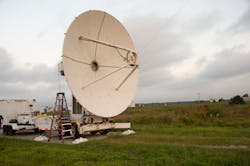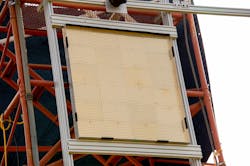A research team from the U.S. Naval Research Laboratory recently demonstrated the feasibility of beaming power by transmitting 1.6 kW of it over 1 km at the Army Research Field in Blossom Point, Md. as part its Safe and Continuous Power Beaming Microwave (SCOPE-M) project.
The equipment used in the project include a transmitting antenna and receiving antenna (rectenna). The transmitter consisted of a 100-kW high-power amplifier to boost the signal going to a microwave dish antenna. The dish could be electronically adjusted so that the beam could be focused at a specific distance.
The power was sent at 10 GHz. This was high enough to keep the beam tightly focused, but not so high that the beam lost power to the atmosphere. In fact, tests showed that even in heavy rain the beam would lose less than 5% of its transmitted power. Equipment needed to work at 10 GHz is also inexpensive and well-tested.
The power density of the beam was low enough that any birds, animals or even humans that might be struck by it would be unharmed. If power levels need to be higher in useful applications, there are accepted ways to switch off the beam if something approaches it, according to NRL engineers.
The beam was received by a rectenna that the team built. It has tens of thousands of x-band antennas, each connected to a small rectifier diode that converts received microwave power into DC electricity.
The team demonstrated power beaming at two locations: one at the Army Research Field at Blossom Point in Maryland, and the other at the Haystack ultrawideband satellite imaging radar (HUSIR) transmitter at the Massachusetts Institute of Technology.
In Maryland, the team exceeded their target by 60% by beaming 1.6 kW of power at just over 1 km. At the MIT site, the team did not have the same peak power, but the average power was much higher, so it delivered more energy. These demonstrations pave the way for power beaming on Earth, in space, and from space to Earth using power densities within safety limits set by international standards bodies, according to researchers.
Beaming power from space is of interest to the Defense Dept. for sending ”fuel” to troops rather than risk using potentially vulnerable convoys or forcing the troops to carry all the fuel they will need.
Beaming solar-generated power from space for consumer use would let power be delivered 24/7 as long as the solar array was in an orbit that kept it in continuous sunshine.


